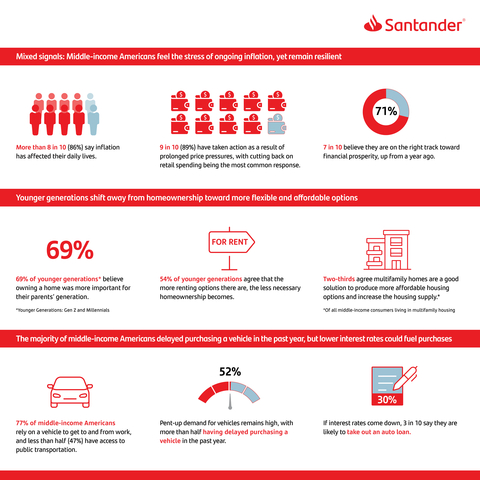Middle-Income Consumers Remain Confident Amidst Price Pressures, Santander US Survey Finds
- 81% consider inflation a major concern, the highest level over the past year.
- Most middle-income households have remained current on their bills, though more are making spending cuts to manage higher prices.
- Gen Z and millennials have shifted their mindset around homeownership and find flexibility in renting, with 6 in 10 believing homeownership as a sign of financial prosperity is outdated.
-
Federal Reserve rate cuts could unlock pent-up vehicle demand, with 52% delaying a vehicle purchase over the last year.
This press release features multimedia. View the full release here: https://www.businesswire.com/news/home/20241008356038/en/

(Graphic: Business Wire)
When it comes to their economic outlook and the possibility of a recession, consumers are sending mixed signals. While economic indicators suggest the economy is stable, a majority of middle-income Americans remain uncertain. More than six in 10 (62%) believe
Amidst concerns about inflation and economic uncertainty, middle-income Americans are adapting to conditions. Most (89%) say they have taken some action, such as scaling back on retail spending, due to inflation. Additionally, less than one in four (22%) are feeling insecure about their finances, down four percentage points from a year ago.
“Consumers continue to take actions to manage their finances and navigate economic stressors,” said
The survey identified a change in mindset around homeownership, which is falling in importance as consumers seek out flexibility and affordability, especially among younger generations. Seven in 10 Gen Z and millennials say owning a home was more important for their parents’ generation. Meanwhile, vehicle access remains a top priority. The majority (85%) say vehicle access gives them more flexibility in where they live. More than half (52%) delayed purchasing a vehicle in the past year due to cost, though lower interest rates on financing options could help fuel more auto purchases.
While many households continue to feel the effects of inflation, few consumers have taken advantage of the higher rates available on savings through a high-yield savings account or certificate of deposit (CD). Six in 10 households have not yet moved their savings to earn a higher rate of interest, and 24% are unaware of the interest rate they currently earn. However, ongoing rate cuts could prompt consumer action. Nearly half (47%) of middle-income Americans say they are likely to open a CD to lock in a higher interest rate as rates decline.
“Many consumers hold misperceptions about opening high-yield savings accounts, including that they are too difficult to open or aren’t worth the effort,” said Wennes. “Many consumers could be putting their hard-earned savings to work for them by opening a high-yield savings account, which can now take only a matter of minutes. At Santander, we are working on introducing a new, national digital offering that will reduce the friction to create a fast onboarding experience and make it easier for customers to take advantage of higher rates.”
The study, which built upon previous research, assessed middle-income Americans’ current financial state and future aspirations, with a focus on how current economic conditions have impacted their households. It also explored their financial relationships with drivers of prosperity.
Homeownership vs. Renting
Middle-income Americans’ perspective on homeownership has shifted, with many now valuing renting as an option. This is especially true among younger generations. Six in 10 Gen Zers and millennials believe homeownership as a sign of financial prosperity is an outdated concept, and more than half (54%) agree that the more renting options there are, the less necessary homeownership becomes. Even among younger homeowners, 46% say owning a home is more trouble than it is worth and miss the financial flexibility of renting.
While many renters cite benefits such as flexibility to pursue employment opportunities and access to more amenities, 60% of them also believe renting is more affordable than having a mortgage, and nearly half (48%) would be comfortable renting forever. Multifamily housing – defined as properties with five or more residential units – have proven to be cost-effective options for many middle-income consumers. Of those residing in a multifamily unit, 66% agree they are a good solution to produce more affordable housing options and increase the housing supply.
Vehicle Access Critical for Consumers
Middle-income Americans continue to rely on vehicle access. The majority (84%) say it provides them with greater flexibility in how they live their lives, and 77% depend on a vehicle to get to work. While more than half (52%) have delayed purchasing a new vehicle in the past year due to cost, more than four in 10 are considering purchasing a new one in the coming 12 months. If interest rates come down in response to rate cuts by the
This research on financial prosperity, conducted by Morning Consult on behalf of Santander US, surveyed 2,202 Americans who are bank and/or financial services customers, ages 18-76. Survey participants are employed or looking for work, own/use at least one financial product and are the primary or shared decision-maker on household finances with household income in the “middle-income” range of
The full report and more information about the Santander US survey is available here.
About Santander US
View source version on businesswire.com: https://www.businesswire.com/news/home/20241008356038/en/
Media:
andrew.simonelli@santander.us
caroline.connolly@santander.us
Source:
